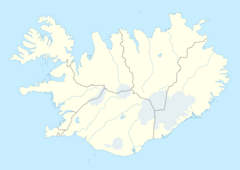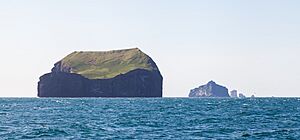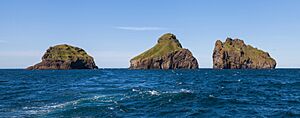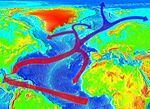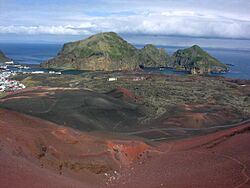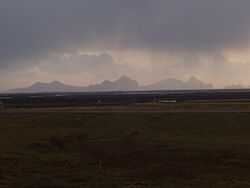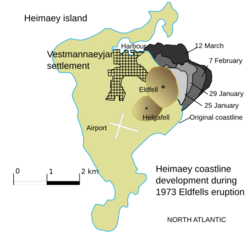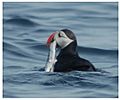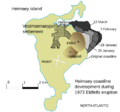Vestmannaeyjar facts for kids
Quick facts for kids
Vestmannaeyjar
|
|
|---|---|
|
Town and municipality
|
|
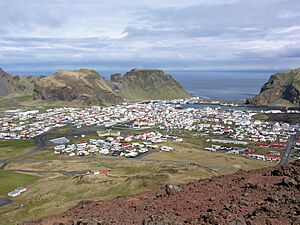
View of Vestmannaeyjabær
|
|
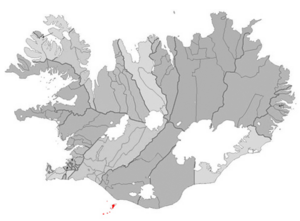
Location of the Municipality of Vestmannaeyjar
|
|
| Country | Iceland |
| Constituency | South Constituency |
| Region | Southern Region |
| County | Vestmannaeyjar |
| Area | |
| • Total | 17 km2 (7 sq mi) |
| Population
(2024)
|
|
| • Total | 4,639 |
| • Density | 250.82/km2 (649.6/sq mi) |
| Time zone | UTC+0 (GMT) |
| Post code |
IS-900, 902
|
Vestmannaeyjar (Icelandic pronunciation: [ˈvɛstˌmanːaˌeiːjar̥]), also known as the Westman Islands, is a group of islands and a town off the south coast of Iceland.
The biggest island is Heimaey. About 4,414 people live there, mostly in the main town called Vestmannaeyjabær. The other islands are empty, but six of them have small cabins for hunting. Vestmannaeyjar became famous around the world in 1973. This was when the Eldfell volcano erupted. The eruption destroyed many buildings and made everyone on the island leave for a month. About one-fifth of the town was ruined. Luckily, people stopped the lava flow by spraying it with huge amounts of cold sea water.
Contents
Exploring the Geography of Vestmannaeyjar
The Vestmannaeyjar islands are quite new in terms of how old the Earth is. They are part of a volcanic area in Southern Iceland. These islands were formed by volcanoes erupting over the last 10,000 to 12,000 years. There are about 70 to 80 volcanoes in this system, both above and below the sea.
Islands of Vestmannaeyjar
The Vestmannaeyjar group includes 18 islands and about 30 rock stacks and skerries (small rocky islands). All the islands were formed by underwater volcanic eruptions. They are made of layers of volcanic ash and lava.
The oldest parts of the islands are on Heimaey, which is the largest and only island where people live. You can see cool rock formations called Basalt columns in many places. The sea has also carved out beautiful coves and caves along the coast. These are some of the special features of the islands.
A new island, Surtsey, was formed in 1963 by an eruption that lasted about four years. This was one of the longest eruptions in Icelandic history. In 1973, another eruption on Heimaey made the island grow by about 2.1 square kilometres (0.81 sq mi). The Vestmannaeyjar group is about 38 kilometres (24 mi) long and 29 kilometres (18 mi) wide. The closest island is about 8 kilometres (5 mi) from the mainland.
Here are some of the main islands:
- Heimaey (13.4 square kilometres; 5.2 sq mi)
- Surtsey (1.4 square kilometres; 0.54 sq mi)
- Elliðaey (0.45 square kilometres; 0.17 sq mi)
- Bjarnarey (0.32 square kilometres; 0.12 sq mi)
- Álsey (0.25 square kilometres; 0.097 sq mi)
- Suðurey (0.20 square kilometres; 0.077 sq mi)
- Brandur (0.1 square kilometres; 0.039 sq mi)
- Hellisey (0.1 square kilometres; 0.039 sq mi)
- Súlnasker (0.03 square kilometres; 7 acres)
- Geldungur (0.02 square kilometres; 5 acres)
- Geirfuglasker (0.02 square kilometres; 5 acres)
- The islands Hani, Hæna, Hrauney and the skerry Grasleysa are known as Smáeyjar (small islands).
The total land area is about 16.3 square kilometres (6.3 sq mi).
Wildlife and Nature in Vestmannaeyjar
Vestmannaeyjar usually gets very little snow but a lot of rain. Because of this special weather, birds that migrate often arrive here first in spring. They also leave from these islands in the autumn.
Bird Species and Their Life Cycle
All of Iceland's seabirds can be found in Vestmannaeyjar. These include the guillemot, gannet, kittiwake, Iceland gull, and puffin. The puffin is the most common bird and is a symbol of Vestmannaeyjar. More than 30 types of birds nest in the cliffs and grassy areas. Millions of birds live here, and other types visit sometimes.
The people in the town have a tradition of helping lost puffins find their way to safe places.
Plants and Sea Life
There are about 150 different kinds of plants on the islands. About 80 types of insects have also been found.
The waters around Vestmannaeyjar are some of the best fishing spots in the North Atlantic. Two important fish for Iceland, cod and haddock, are found in large numbers here. Other fish like flat-fish, herring, and capelin are also caught. These fish swim through the area in autumn and winter.
Lobsters and ocean perch are found in deep waters southeast of the islands. You can also see many seals, small types of whales, and other sea animals around the islands.
Climate and Weather in Vestmannaeyjar
Vestmannaeyjar has a cool ocean climate. It gets a lot of rain for how far north it is. It is often very windy on the islands. The strongest wind ever recorded in Iceland (61 metres per second; 140 mph; 220 km/h) was measured in Stórhöfði. This is one of the island's two main peninsulas. The wind usually blows from the east and southeast.
The islands have the highest average yearly temperature in Iceland. This is because the Gulf Stream brings warm ocean currents, especially in winter.
| Climate data for Vestmannaeyjar, 1981–2010 normals, extremes 1949–2013 | |||||||||||||
|---|---|---|---|---|---|---|---|---|---|---|---|---|---|
| Month | Jan | Feb | Mar | Apr | May | Jun | Jul | Aug | Sep | Oct | Nov | Dec | Year |
| Record high °C (°F) | 9.2 (48.6) |
10.0 (50.0) |
9.0 (48.2) |
11.6 (52.9) |
16.5 (61.7) |
19.3 (66.7) |
21.6 (70.9) |
20.3 (68.5) |
15.4 (59.7) |
13.4 (56.1) |
10.5 (50.9) |
10.0 (50.0) |
21.6 (70.9) |
| Mean daily maximum °C (°F) | 3.8 (38.8) |
3.8 (38.8) |
3.9 (39.0) |
5.6 (42.1) |
8.4 (47.1) |
10.5 (50.9) |
12.3 (54.1) |
12.1 (53.8) |
9.8 (49.6) |
6.8 (44.2) |
5.0 (41.0) |
4.1 (39.4) |
7.2 (45.0) |
| Daily mean °C (°F) | 1.8 (35.2) |
1.7 (35.1) |
1.8 (35.2) |
3.5 (38.3) |
6.1 (43.0) |
8.4 (47.1) |
10.1 (50.2) |
10.2 (50.4) |
8.0 (46.4) |
5.1 (41.2) |
3.2 (37.8) |
2.1 (35.8) |
5.2 (41.4) |
| Mean daily minimum °C (°F) | −0.3 (31.5) |
−0.4 (31.3) |
−0.2 (31.6) |
1.7 (35.1) |
4.4 (39.9) |
6.9 (44.4) |
8.6 (47.5) |
8.7 (47.7) |
6.5 (43.7) |
3.5 (38.3) |
1.3 (34.3) |
0.2 (32.4) |
3.4 (38.1) |
| Record low °C (°F) | −15.7 (3.7) |
−16.3 (2.7) |
−14.9 (5.2) |
−16.9 (1.6) |
−7.1 (19.2) |
−1.4 (29.5) |
3.7 (38.7) |
2.6 (36.7) |
−2.6 (27.3) |
−7.5 (18.5) |
−10.7 (12.7) |
−15.3 (4.5) |
−16.9 (1.6) |
| Average precipitation mm (inches) | 159.4 (6.28) |
141.9 (5.59) |
137.1 (5.40) |
112.6 (4.43) |
94.1 (3.70) |
83.6 (3.29) |
103.4 (4.07) |
137.9 (5.43) |
153.6 (6.05) |
154.8 (6.09) |
153.7 (6.05) |
165.7 (6.52) |
1,597.9 (62.91) |
| Average precipitation days (≥ 1.0 mm) | 19.3 | 18.1 | 17.6 | 15.3 | 13.5 | 11.5 | 13.4 | 15.3 | 17.1 | 16.7 | 16.5 | 18.5 | 192.0 |
| Average snowy days (≥ 0 cm) | 8.7 | 7.4 | 6.5 | 1.9 | 0.4 | 0.0 | 0.0 | 0.0 | 0.0 | 0.6 | 2.9 | 6.2 | 33.9 |
| Average relative humidity (%) | 78.8 | 79.6 | 78.5 | 80.1 | 82.4 | 87.2 | 88.3 | 87.4 | 84.4 | 82.8 | 79.8 | 78.7 | 82.3 |
| Average dew point °C (°F) | −1.5 (29.3) |
−1.7 (28.9) |
−1.8 (28.8) |
0.0 (32.0) |
3.1 (37.6) |
6.2 (43.2) |
8.2 (46.8) |
8.1 (46.6) |
5.4 (41.7) |
2.0 (35.6) |
0.0 (32.0) |
−1.3 (29.7) |
2.2 (36.0) |
| Source 1: NOAA (humidity 1961-1990) | |||||||||||||
| Source 2: Iceland Met Office (extremes) | |||||||||||||
| Coastal temperature data for Vestmannaeyjar | |||||||||||||
|---|---|---|---|---|---|---|---|---|---|---|---|---|---|
| Month | Jan | Feb | Mar | Apr | May | Jun | Jul | Aug | Sep | Oct | Nov | Dec | Year |
| Average sea temperature °C (°F) | 6.3 (43.34) |
6.5 (43.70) |
6.3 (43.34) |
6.7 (44.06) |
8.0 (46.40) |
9.3 (48.74) |
11.1 (51.98) |
11.6 (52.88) |
11.0 (51.80) |
8.7 (47.66) |
7.6 (45.68) |
6.9 (44.42) |
8.3 (47.00) |
| Source 1: Seatemperature.net | |||||||||||||
History and Naming of Vestmannaeyjar
The islands are named after people called Gaels. These were people from Britain and Ireland who were captured by Norsemen (Vikings). The Old Norse word Vestmenn means "Westmen". This name was used for Celts from Britain and Ireland. It stuck in Icelandic, even though Iceland is further west.
Early History and the Name's Origin
Soon after Ingólfr Arnarson arrived in Iceland, his friend Hjörleifr Hróðmarsson was killed. His own enslaved workers had murdered him. Ingólfur found them on the Vestmannaeyjar islands and killed them all to get revenge. This is why the islands are called Vestmannaeyjar, meaning "the islands of the west men." This event likely happened around the year 875 AD.
Pirate Raids and Island Life
On July 16, 1627, a group of ships from Barbary Pirates attacked the islands. This event is known as the Turkish Abductions. The pirates stayed for a few days. They had also raided other parts of Iceland.
The pirates captured 234 people from the islands. They took them on a 27-day journey to Algiers. Most of these people spent the rest of their lives in slavery. One person, a minister named Ólafur Egilsson, managed to return in 1628. He wrote a book about his experience. In 1636, money was paid to free 34 of the captives. Most of them then returned to Iceland. After this, a small fort was built on Skansinn. An armed guard was also set up to watch for ships from the mountain Helgafell.
For many centuries, the people of Vestmannaeyjar had a very hard life. They survived by fishing and collecting wild birds and their eggs from the cliffs. At the end of the 1800s, when about 600 people lived there, things started to change a lot. In 1904, the first boat with an engine was bought. More motorized boats followed soon after. By 1930, the population had grown to 3,470 people.
Vestmannaeyjar has always been a leader in fishing and seafood processing. It is the most productive fishing center in Iceland. For a long time, getting fresh water was a problem. But in 1968, a pipeline was built, which made things much better.
Volcanic Activity and Modern Times
The area is very active with volcanoes, just like the rest of Iceland. There were two big eruptions in the 20th century. The first was in 1963, which created the new island of Surtsey. The second was the Eldfell eruption in January 1973. This eruption created a new mountain 200 meters high where there used to be a meadow. It also caused all 5,000 islanders to be moved to the mainland for a while.
In 2000, a replica of a old Norwegian church, the Heimaey stave church, was built at Skansinn. This was a gift from the Norwegian government to Iceland. It celebrated 1,000 years since Iceland became Christian.
Getting to Vestmannaeyjar
A ferry service connects Vestmannaeyjar to the mainland. It usually runs from Landeyjahöfn, which is closer. If the weather is bad, it sometimes goes to Þorlákshöfn, which is further away. The new Landeyjahöfn harbor opened in 2010. This made the ferry trip much shorter, about 40 minutes.
A new electric ferry started working in July 2019. It has a large battery and can carry 550 passengers and 75 cars. This ferry uses much less fuel. It uses electricity for the 13 km trip.
Vestmannaeyjar Airport used to have regular flights to Reykjavík. However, as of 2023, there are no regular flights. Icelandair has flown special charter flights for the Þjóðhátíð festival in 2022 and 2023.
Famous People from Vestmannaeyjar
Many talented people have come from Vestmannaeyjar. Here are a few:
- Ásgeir Sigurvinsson (born 1955), a retired footballer. He was born in Vestmannaeyjar.
- Elísa Viðarsdóttir (born 1991), a footballer who started her career at ÍBV.
- Elsa Guðbjörg Vilmundardóttir (1932–2008), Iceland's first female geologist.
- Fanndís Friðriksdóttir (born 1990), a footballer who trained at ÍBV's youth program.
- Heimir Hallgrímsson (born 1967), the manager of the Iceland national football team. He was born in Vestmannaeyjar.
- Helgi Ólafsson (born 1956), a chess grandmaster.
- Hermann Hreiðarsson (born 1974), a footballer.
- Margrét Lára Viðarsdóttir (born 1986), a retired footballer. Many consider her the best Icelandic female footballer ever.
- Ólafur Egilsson (1564–1639), a minister who was kidnapped in 1627. He later wrote a book about his experiences.
- Smári McCarthy (born 1984), an information activist and politician. He grew up in Vestmannaeyjar.
- Sólveig Anspach (1960–2015), a film director and screenwriter.
Images for kids
-
Puffin with capelin
-
February 2009 south aerial view of Súlnasker Geldungur, Hellisey, Álsey, Brandur, Suðurey, Heimaey, Bjarnarey, Elliðaey, with the Icelandic mainland in the background
-
Heimaklettur seen from Stakkagerðistún which is a public park in the middle of Heimaey
See also
 In Spanish: Islas Vestman para niños
In Spanish: Islas Vestman para niños


